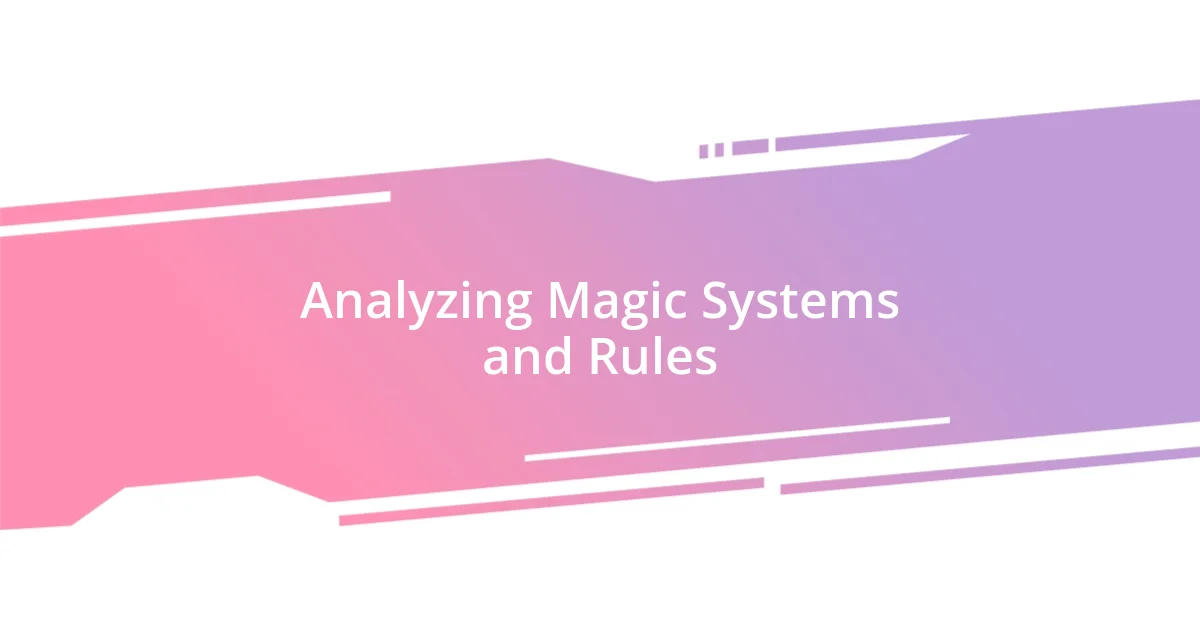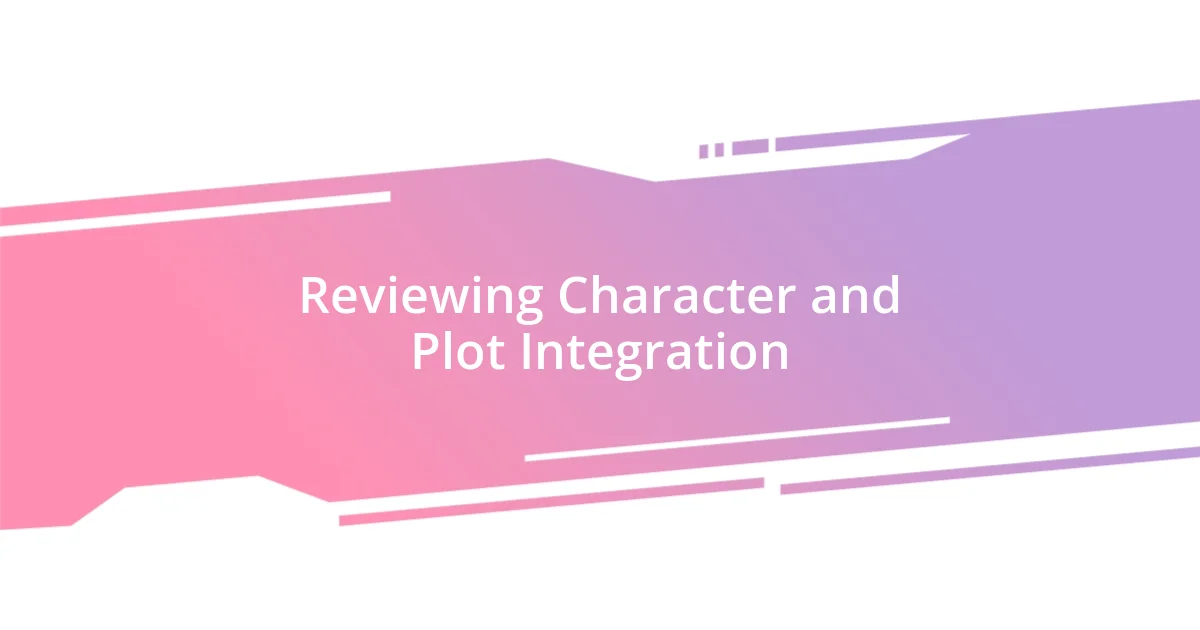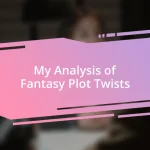Key takeaways:
- Elements of fantasy world-building, such as geography, history, culture, and magic systems, are crucial for creating immersive narratives and character motivations.
- Effective integration of characters and plot is essential; character development often shines during moments of conflict and moral dilemmas.
- Evaluating world-building involves assessing individual elements and their interconnections, which significantly influence reader engagement and emotional investment.

Understanding Fantasy World-Building
Fantasy world-building is like creating a second universe, and the depth of that creation can be both thrilling and daunting. I remember the first time I dove into a rich universe, feeling completely absorbed by the intricate details—from the geography to the culture. How can a reader not be captivated by a world that feels as real as their own?
When I think about the elements of fantasy world-building, I can’t help but appreciate how each aspect contributes to the overall narrative. The history and mythology not only create a setting but also enrich the characters’ motivations. Have you ever noticed how certain fantastical realms evoke emotions even before a character speaks? That’s the power of a well-crafted world.
In my experience, the connections between the characters and their environment shape the entire storyline. Each choice an author makes—like the language spoken or the customs practiced—provides a lens through which readers experience the journey. It’s fascinating to consider how these elements can either draw a reader in or push them away; what kind of world would you want to immerse yourself in?

Key Elements of World-Building
When I evaluate a fantasy world, I’m always on the lookout for key elements that breathe life into the narrative. One essential aspect is the geography, which serves as a backdrop for all adventures. I recall getting lost in a world where mountains were rumored to house ancient dragons, and dense forests concealed hidden spells. Such vivid landscapes can evoke wonder and a sense of curiosity that pulls you deeper into the story.
Here’s a quick rundown of what I consider key elements in world-building:
- Geography: Environments that influence the story and its characters.
- History: Events that shape cultures and societal norms.
- Culture: The beliefs, traditions, and practices of the inhabitants.
- Politics: The power dynamics and governance systems at play.
- Magic System: The rules and limitations of magic that can enrich the plot.
- Economy: Trade and commerce that create motivations for characters.
Each of these elements can create a tapestry of intrigue, inviting readers to explore every corner of the world. It’s as if the universe itself opens up a dialogue with the reader, making each turn of the page feel like a step into the unknown. I love how a well-thought-out economy can give rise to conflicts that drive the plot; it’s these connections that keep things fascinating.

Evaluating Setting and Geography
When I evaluate the setting and geography of a fantasy world, I look for how they shape the narrative. I remember being enchanted by a sprawling desert that felt both oppressive and liberating, serving as a character in its own right. Such landscapes not only influence the journey but also reflect the internal struggles of characters, creating rich layers of meaning.
Geography can often dictate societal development. For example, a mountain range can separate cultures, fostering unique histories and conflicts. I’ve always found it fascinating how rivers might act as borders, while oceans can serve as gateways to adventure or isolation. The interplay of these elements can create tension or harmony, which reflects the journey that a character may undergo.
Now, let’s put this into perspective with a simple table to summarize key elements related to setting and geography:
| Element | Importance |
|---|---|
| Physical Geography | Shapes culture and societal interactions |
| Resource Availability | Influences trade, power dynamics, and conflicts |
| Climate | Affects character behavior and story mood |
| Natural Barriers | Create conflict or protect communities |

Assessing Culture and Society
When assessing culture and society in a fantasy world, I’m particularly drawn to the nuances of daily life—things like festivals, food, and family structures. I think about how the traditions of a culture can reflect its history and values. For instance, one time, I encountered a world where the harvest festival wasn’t just a celebration; it was a deeply spiritual event that connected the community to their ancestral spirits. Doesn’t it make you wonder how such traditions shape the identities of their people?
Language, too, plays a pivotal role in building culture. I’ve always been fascinated by how different dialects can hint at societal divisions or cooperation within a world. In one book I read, a character’s unique accent was a marker of her outsider status, generating both tension and intrigue in her interactions. Isn’t it intriguing how something as simple as speech can convey so much about social standing and group dynamics?
Moreover, the moral codes and ethical dilemmas faced by characters can reveal a lot about a culture’s core beliefs. I remember a story that posed the question: “Is it right to sacrifice one for the many?” This dilemma not only shaped the characters’ actions but also opened a window into the society’s collective ethics. Such explorations compel me to reflect on our own world and the moral complexities that exist within our societies. What insights can we glean about ourselves from the fictional cultures we explore?

Analyzing Magic Systems and Rules
When I analyze magic systems, I look for their internal logic and consistency. A well-crafted magic system feels like an extension of the world itself, influencing everything from societal structure to character development. For instance, in a book I read, the protagonist’s ability to harness fire magic came with strict limitations: using it too often could lead to severe physical burns. This kind of consequence adds depth, forcing characters to make tough decisions that resonate emotionally with readers.
I also consider how magic fits into the cultural fabric of the world. Take a fantasy series I once explored where magic was reserved for a select few, shaping an aristocracy that wielded power through exclusive knowledge. This division created tension and conflict, making me ponder how power dynamics change when such abilities are controlled rather than widespread. Isn’t it fascinating how magic can be a tool for both good and evil, reflecting the complexities of real-world hierarchies?
Moreover, the rules governing magic can reveal character flaws and growth. I remember a character who abused their magical abilities, only to face dire consequences that led to a profound arc of redemption. It made me think—what happens when we overlook the responsibilities that come with our own talents? Magic, in this context, becomes a powerful metaphor for our struggles and decisions in life, and it’s this contrast that truly captivates my imagination.

Reviewing Character and Plot Integration
Characters and plot should intertwine seamlessly; when they don’t, it can feel jarring. I remember reading a series where a character’s motivations seemed out of sync with the plot, leading to disjointed interactions. It made me question: how crucial is alignment between a character’s personal journey and the overarching narrative?
I often find that moments of conflict reveal the best character development. For instance, in a fantasy novel I enjoyed, the protagonist faced a moral dilemma that tested her loyalties to both her friends and her country. This situation not only advanced the plot but also deepened my connection to her struggles. Don’t you love when those twists reveal vulnerabilities that make characters feel real and relatable?
Moreover, character arcs should reflect the changing dynamics of the plot. I recall being particularly moved by a story where the villain transformed into an unlikely ally, driven by newfound empathy after a shared trauma. This revitalized not just the character but the entire narrative. How captivating it is to see that evolution—and how relevant it feels to our own journeys toward understanding and forgiveness!

Tips for Each Evaluation Stage
When I think about evaluating the world-building in fantasy settings, I focus on the individual stages of assessment, and each one brings unique insights. For example, during the initial review, I often jot down what elements stand out to me, like cultural details or geography. This helps me identify what resonates with me personally. Have you ever noticed how the smallest details, like a unique tradition or a peculiar creature, can spark your imagination in unexpected ways?
As I dive deeper into character development, I make it a point to connect back to the world itself. I remember reading a story where the protagonist’s cultural background deeply influenced her choices, shaping her journey. It drew me in because I could relate her experiences to real-world cultural nuances. Isn’t it powerful when an author infuses a character’s identity with authentic, relatable issues?
Finally, during my evaluation of plot cohesion, I pay close attention to pacing. A well-structured narrative has a rhythm that matches the world where it unfolds. One novel I voraciously read had a fast-paced adventure intertwined with reflective moments that allowed me to appreciate the complexities of its universe. How does the story’s tempo affect your emotional investment in the characters? It’s these nuances that truly elevate a fantasy world from mere escapism to something profoundly engaging, creating a lasting impact.














